微生物英文名词解释
- 格式:doc
- 大小:168.50 KB
- 文档页数:16
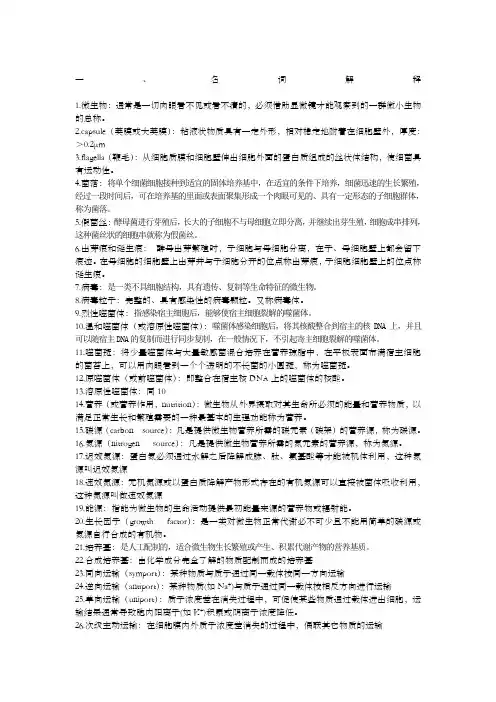
一、名词解释1.微生物:通常是一切肉眼看不见或看不清的,必须借助显微镜才能观察到的一群微小生物的总称。
2.capsule(荚膜或大荚膜):粘液状物质具有一定外形,相对稳定地附着在细胞壁外,厚度:>0.2µm3.flagella(鞭毛):从细胞质膜和细胞壁伸出细胞外面的蛋白质组成的丝状体结构,使细菌具有运动性。
4.菌落:将单个细菌细胞接种到适宜的固体培养基中,在适宜的条件下培养,细菌迅速的生长繁殖,经过一段时间后,可在培养基的里面或表面聚集形成一个肉眼可见的、具有一定形态的子细胞群体,称为菌落。
5.假菌丝:酵母菌进行芽殖后,长大的子细胞不与母细胞立即分离,并继续出芽生殖,细胞成串排列,这种菌丝状的细胞串就称为假菌丝。
6.出芽痕和诞生痕:酵母出芽繁殖时,子细胞与母细胞分离,在子、母细胞壁上都会留下痕迹。
在母细胞的细胞壁上出芽并与子细胞分开的位点称出芽痕,子细胞细胞壁上的位点称诞生痕。
7.病毒:是一类不具细胞结构,具有遗传、复制等生命特征的微生物。
8.病毒粒子:完整的、具有感染性的病毒颗粒。
又称病毒体。
9.烈性噬菌体:指感染宿主细胞后,能够使宿主细胞裂解的噬菌体。
10.温和噬菌体(或溶原性噬菌体):噬菌体感染细胞后,将其核酸整合到宿主的核DNA上,并且可以随宿主DNA的复制而进行同步复制,在一般情况下,不引起寄主细胞裂解的噬菌体。
11.噬菌斑:将少量噬菌体与大量敏感菌混合培养在营养琼脂中,在平板表面布满宿主细胞的菌苔上,可以用肉眼看到一个个透明的不长菌的小圆斑,称为噬菌斑。
12.原噬菌体(或前噬菌体):即整合在宿主核DNA上的噬菌体的核酸。
13.溶原性噬菌体:同1014.营养(或营养作用,nutrition):微生物从外界摄取对其生命所必须的能量和营养物质,以满足正常生长和繁殖需要的一种最基本的生理功能称为营养。
15.碳源(carbon source):凡是提供微生物营养所需的碳元素(碳架)的营养源,称为碳源。
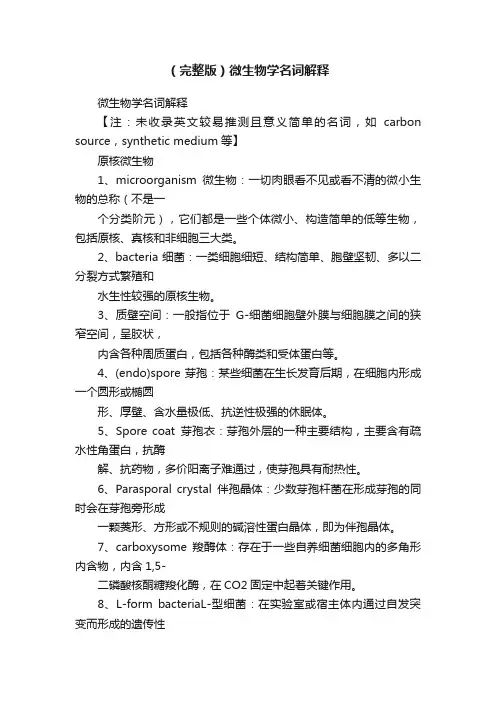
(完整版)微生物学名词解释微生物学名词解释【注:未收录英文较易推测且意义简单的名词,如carbon source,synthetic medium等】原核微生物1、microorganism微生物:一切肉眼看不见或看不清的微小生物的总称(不是一个分类阶元),它们都是一些个体微小、构造简单的低等生物,包括原核、真核和非细胞三大类。
2、bacteria细菌:一类细胞细短、结构简单、胞壁坚韧、多以二分裂方式繁殖和水生性较强的原核生物。
3、质壁空间:一般指位于G-细菌细胞壁外膜与细胞膜之间的狭窄空间,呈胶状,内含各种周质蛋白,包括各种酶类和受体蛋白等。
4、(endo)spore芽孢:某些细菌在生长发育后期,在细胞内形成一个圆形或椭圆形、厚壁、含水量极低、抗逆性极强的休眠体。
5、Spore coat芽孢衣:芽孢外层的一种主要结构,主要含有疏水性角蛋白,抗酶解、抗药物,多价阳离子难通过,使芽孢具有耐热性。
6、Parasporal crystal伴孢晶体:少数芽孢杆菌在形成芽孢的同时会在芽孢旁形成一颗菱形、方形或不规则的碱溶性蛋白晶体,即为伴孢晶体。
7、carboxysome羧酶体:存在于一些自养细菌细胞内的多角形内含物,内含1,5-二磷酸核酮糖羧化酶,在CO2固定中起着关键作用。
8、L-form bacteriaL-型细菌:在实验室或宿主体内通过自发突变而形成的遗传性稳定的细胞壁缺损菌株。
9、fimbria菌毛:一类长在细菌体表的纤细、中空、短直、数量较多的蛋白质附属物,具有使菌体附着于物体表面的功能。
10、flagella鞭毛:生长在某些细菌表面的长丝状、波曲的蛋白质附属物,其数目为一至数十条,具有运动能力。
11、sexpilus(pl. pili)性毛:构造与成分与菌毛相同,但比菌毛长,每个细胞一至少数几根,一般见于G-雄性菌株,具有传递遗传物质的功能。
12、mesosome间体:细菌细胞中一种由细胞质膜内褶而形成的囊状结构,其中充满着层状或管状的泡囊,多见于G+细菌。
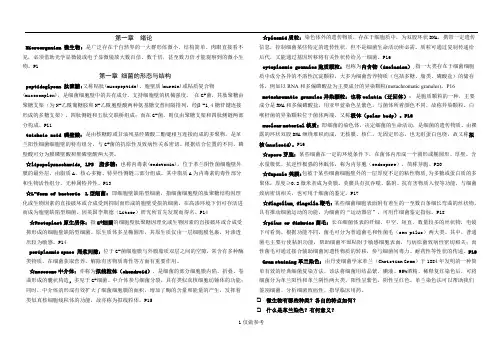
第一章绪论Microorganism 微生物: 是广泛存在于自然界的一大群形体微小、结构简单、肉眼直接看不见,必须借助光学显微镜或电子显微镜放大数百倍、数千倍,甚至数万倍才能观察到的微小生物。
P1第一章细菌的形态与结构peptidoglycan 肽聚糖:又称粘肽(mucopeptide)、胞壁质(murein)或粘质复合物(mucocomplex),是细菌细胞壁中的共有成分,支持细胞壁的机械强度。
在G+菌,其肽聚糖由聚糖支架(为N-乙酰葡糖胺和N-乙酰胞壁酸两种氨基糖交替间隔排列,经β-1,4糖苷键连接形成的多糖支架),四肽侧链和五肽交联桥组成;而在G-菌,则仅由聚糖支架和四肽侧链两部分构成。
P11teichoic acid 磷壁酸:是由核糖醇或甘油残基经磷酸二酯键相互连接而成的多聚物,是革兰阳性细菌细胞壁的特有组分,与G+菌的抗原性及致病性关系密切。
根据结合位置的不同,磷壁酸可分为膜磷壁酸和壁磷壁酸两大类。
☆lipopolysaccharide, LPS 脂多糖:也称内毒素(endotoxin),位于革兰阴性菌细胞壁外膜的最外层,由脂质A、核心多糖、特异性侧链三部分组成。
其中脂质A为内毒素的毒性部分和生物活性组分,无种属特异性。
P13☆L-form of bacteria L型细菌:即细胞壁缺陷型细菌,指细菌细胞壁的肽聚糖结构因理化或生物因素的直接破坏或合成受到抑制而形成的胞壁受损的细菌,在高渗环境下仍可存活进而成为胞壁缺陷型细菌。
因英国李斯德(Litser)研究所首先发现而得名。
P14 ☆Protoplast原生质体:指G+细菌的细胞壁肽聚糖因理化或生物因素的直接破坏或合成受抑形成的细胞壁缺陷型细菌。
原生质体多呈椭圆形,其原生质仅由一层细胞膜包裹,对渗透压较为敏感。
P14periplasmic space 周浆间隙:位于G-菌细胞膜与外膜脂质双层之间的空隙,常含有多种酶类物质,在细菌获取营养,解除有害物质毒性等方面有重要作用。
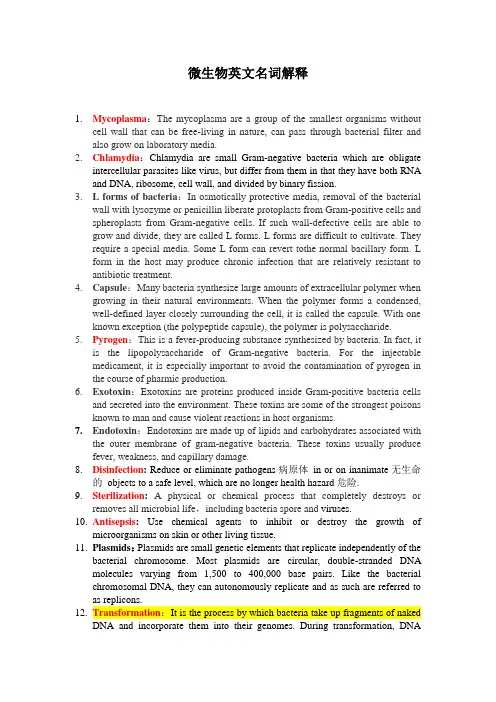
微生物英文名词解释1.Mycoplasma:The mycoplasma are a group of the smallest organisms withoutcell wall that can be free-living in nature, can pass through bacterial filter and also grow on laboratory media.2.Chlamydia:Chlamydia are small Gram-negative bacteria which are obligateintercellular parasites like virus, but differ from them in that they have both RNA and DNA, ribosome, cell wall, and divided by binary fission.3.L forms of bacteria:In osmotically protective media, removal of the bacterialwall with lysozyme or penicillin liberate protoplasts from Gram-positive cells and spheroplasts from Gram-negative cells. If such wall-defective cells are able to grow and divide, they are called L forms. L forms are difficult to cultivate. They require a special media. Some L form can revert tothe normal bacillary form. L form in the host may produce chronic infection that are relatively resistant to antibiotic treatment.4.Capsule:Many bacteria synthesize large amounts of extracellular polymer whengrowing in their natural environments. When the polymer forms a condensed, well-defined layer closely surrounding the cell, it is called the capsule. With one known exception (the polypeptide capsule), the polymer is polysaccharide.5.Pyrogen:This is a fever-producing substance synthesized by bacteria. In fact, itis the lipopolysaccharide of Gram-negative bacteria. For the injectable medicament, it is especially important to avoid the contamination of pyrogen in the course of pharmic production.6.Exotoxin:Exotoxins are proteins produced inside Gram-positive bacteria cellsand secreted into the environment. These toxins are some of the strongest poisons known to man and cause violent reactions in host organisms.7.Endotoxin:Endotoxins are made up of lipids and carbohydrates associated withthe outer membrane of gram-negative bacteria. These toxins usually produce fever, weakness, and capillary damage.8.Disinfection: Reduce or eliminate pathogens病原体in or on inanimate无生命的objects to a safe level, which are no longer health hazard危险.9.Sterilization: A physical or chemical process that completely destroys orremoves all microbial life,including bacteria spore and viruses.10.Antisepsis: Use chemical agents to inhibit or destroy the growth ofmicroorganisms on skin or other living tissue.11.Plasmids:Plasmids are small genetic elements that replicate independently of thebacterial chromosome. Most plasmids are circular, double-stranded DNA molecules varying from 1,500 to 400,000 base pairs. Like the bacterial chromosomal DNA, they can autonomously replicate and as such are referred to as replicons.12.Transformation:It is the process by which bacteria take up fragments of nakedDNA and incorporate them into their genomes. During transformation, DNAfragments from a dead degraded bacterium bind to DNA binding proteins on the surface of a competent recipient bacterium.13.Conjugation:Conjugation is the transfer of DNA directly from a living donorbacterium to a recipient bacterium during the mating of the bacteria. A sex pilus produced by the donor bacterium (or male) binds to the recipient (or female). The sex pilus then retracts, bringing the two bacteria in contact and the transferred DNA passes through the sex pilus.14.Transduction:Transduction is mediated by a bacteriophage, which pick upfragments of DNA and package them into bacteriophage particles. The DNA is delivered to infected cells and becomes incorporated into the bacterial genomes.15.Normal flora:The various bacteria and fungi that are permanent residents ofcertain body sites, especially the skin, oropharynx, colon, and vagina.16.Dysbacteriosis:If flora disequilibrium occurs, for example, when the residentflora is disturbed, some little significant microorganisms may colonize, proliferate and produce diseases, which are called dysbacteriosis. Dysbacteriosis mainly result from long term and large bacteriosis mainly result from long term and large bacteriosis mainly result from long term and large doses antibiotics taken. Antibiotics can suppress the drug-susceptible components of fecal flora.Soon thereafter the counts of fecal flora rise again to normal or higher than normal levels, principally of organisms selected out because of relative resistance to the drugs employed. The drug susceptible microorganisms are replaced by drug-resistant ones and cause correlative disease, microbial selection and substitution.17.Toxemia:Bacteria multiply at invading location and do not enter blood stream,but the exotoxins enter blood and cause corresponding toxic symptoms.18.Endotoxemia:Gram-negative bacteria multiply at location or in blood stream,release a lot of amount endotoxin released from bacterial cell rupture.19.Protein A :Protein A is a cell wall component of many S. aureus strains thatbinds to the Fc portion of IgG molecules except IgG3. The Fab portion of IgG bound to protein A is free to combine with a specific antigen. Protein A has become an important reagent in immunology and diagnostic laboratory technology; for example, protein A with attached IgG molecules directed againsta specific bacterial antigen will agglutinate bacteria that have that antigen(“coagglutination”). Protein A probably contributes to the virulence of S. aureus by interfering with opsonization.20.Elementary body(EB):Elementary body(EB)are small round cells about0.2~0.4μm with an electron-dense nucleoid. They possess a cell wall. They areextracellular form and the environmentally stable infectious particle ,and metabolically inactive. The EB have a high affinity for host epithelial cells and rapidly enter them,creating a protected membrane-bound environment around the chlamydiae,and the Elementary body is reorganized into a larger one called metabolically active Reticulate body(RB).21.Reticulate body(RB):The intracellular large form known as the reticulate bodyMeasuring about 0.5~1μm and devoid of an electron-dense nucleoid. Itspresence will reflect the stage of replication. Within the membrane-bound vacuole,the elementary grows in size and divides into repeatedly by binary fission. Eventually,the entire vacuole becomes filled with elementary bodies derived from reticulate bodies to form a cytoplasmic inclusion. The newly formed elementary bodies may be liberated from the host cell to infect new cells. The developmental cycle takes 24-48 hours.22.nucleocapsid:The simplest of virus particles consists of a protein coat (capsid)which surrounds a strand of nucleic acid and are thus called naked viruses or nucleocapsid.23.Abortive Infections:Not all infections lead to new progeny virus. Productiveinfections occur in permissive cells and result in the production of infectious virus. Abortive infections fail to produce infectious progeny, either because the cell may be nonpermissive and unable to support the expression of all viral genes or because the infecting virus may be defective, lacking some functional viral gene.24.defective virus:A defective virus is one that lacks one or more functional genesrequired for viral replication. Defective viruses require helper activity from another virus for some step in replication or maturation. One type of defective virus lacks a portion of its genome (i.e., deletion mutant). The extent of loss by deletion may vary from a short base sequence to a large amount of the genome.Deletion mutants may arise spontaneously or may be constructed in the laboratory using biochemical techniques.25.Interferons (IFN s):Interferons (IFN s)are proteins made and released by hostcells in response to the presence of pathogens such as viruses, bacteria, parasites or tumor cells. They allow for communication between cells to trigger the protective defences of the immune system that eradicate pathogens or tumors. 26.Antigenic drift: Antigenic drift is constantly occurring in both influenza A andinfluenza B viruses. The HA and/or NA of the new strain are sufficiently different to evade (at least partially) the pre-existing human immunity. This leads to the seasonal epidemics.27.Antigenic shift:Antigenic shift occurs only in influenza A virus. It describes theemergence of an entirely new virus sub type. When this new sub type emerges, it causes a pandemic because there is no pre-existing immunity in humans.。
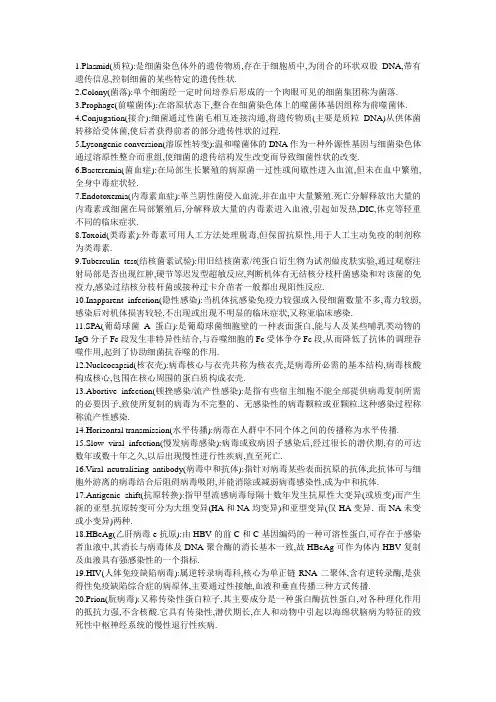
1.Plasmid(质粒):是细菌染色体外的遗传物质,存在于细胞质中,为闭合的环状双股DNA,带有遗传信息,控制细菌的某些特定的遗传性状.2.Colony(菌落):单个细菌经一定时间培养后形成的一个肉眼可见的细菌集团称为菌落.3.Prophage(前噬菌体):在溶原状态下,整合在细菌染色体上的噬菌体基因组称为前噬菌体.4.Conjugation(接合):细菌通过性菌毛相互连接沟通,将遗传物质(主要是质粒DNA)从供体菌转移给受体菌,使后者获得前者的部分遗传性状的过程.5.Lysongenic conversion(溶原性转变):温和噬菌体的DNA作为一种外源性基因与细菌染色体通过溶原性整合而重组,使细菌的遗传结构发生改变而导致细菌性状的改变.6.Bacteremia(菌血症):在局部生长繁殖的病原菌一过性或间歇性进入血流,但未在血中繁殖,全身中毒症状轻.7.Endotoxemia(内毒素血症):革兰阴性菌侵入血流,并在血中大量繁殖.死亡分解释放出大量的内毒素或细菌在局部繁殖后,分解释放大量的内毒素进入血液,引起如发热,DIC,休克等轻重不同的临床症状.8.Toxoid(类毒素):外毒素可用人工方法处理脱毒,但保留抗原性,用于人工主动免疫的制剂称为类毒素.9.Tuberculin test(结核菌素试验):用旧结核菌素/纯蛋白衍生物为试剂做皮肤实验,通过观察注射局部是否出现红肿,硬节等迟发型超敏反应,判断机体有无结核分枝杆菌感染和对该菌的免疫力,感染过结核分枝杆菌或接种过卡介苗者一般都出现阳性反应.10.Inapparent infection(隐性感染):当机体抗感染免疫力较强或入侵细菌数量不多,毒力较弱,感染后对机体损害较轻,不出现或出现不明显的临床症状,又称亚临床感染.11.SPA(葡萄球菌A蛋白):是葡萄球菌细胞壁的一种表面蛋白,能与人及某些哺乳类动物的IgG分子Fc段发生非特异性结合,与吞噬细胞的Fc受体争夺Fc段,从而降低了抗体的调理吞噬作用,起到了协助细菌抗吞噬的作用.12.Nucleocapsid(核衣壳):病毒核心与衣壳共称为核衣壳,是病毒所必需的基本结构,病毒核酸构成核心,包围在核心周围的蛋白质构成衣壳.13.Abortive infection(顿挫感染/流产性感染):是指有些宿主细胞不能全部提供病毒复制所需的必要因子,致使所复制的病毒为不完整的、无感染性的病毒颗粒或亚颗粒.这种感染过程称称流产性感染.14.Horizontal transmission(水平传播):病毒在人群中不同个体之间的传播称为水平传播.15.Slow viral infection(慢发病毒感染):病毒或致病因子感染后,经过很长的潜伏期,有的可达数年或数十年之久,以后出现慢性进行性疾病,直至死亡.16.Viral neutralizing antibody(病毒中和抗体):指针对病毒某些表面抗原的抗体,此抗体可与细胞外游离的病毒结合后阻碍病毒吸附,并能消除或减弱病毒感染性,成为中和抗体.17.Antigenic shift(抗原转换):指甲型流感病毒每隔十数年发生抗原性大变异(或质变)而产生新的亚型.抗原转变可分为大组变异(HA和NA均变异)和亚型变异(仅HA变异.而NA未变或小变异)两种.18.HBeAg(乙肝病毒e抗原):由HBV的前C和C基因编码的一种可溶性蛋白,可存在于感染者血液中,其消长与病毒体及DNA聚合酶的消长基本一致,故HBeAg可作为体内HBV复制及血液具有强感染性的一个指标.19.HIV(人体免疫缺陷病毒):属逆转录病毒科,核心为单正链RNA二聚体,含有逆转录酶,是获得性免疫缺陷综合症的病原体,主要通过性接触,血液和垂直传播三种方式传播.20.Prion(朊病毒):又称传染性蛋白粒子.其主要成分是一种蛋白酶抗性蛋白,对各种理化作用的抵抗力强,不含核酸.它具有传染性,潜伏期长,在人和动物中引起以海绵状脑病为特征的致死性中枢神经系统的慢性退行性疾病.21.Widal test(肥达氏试验):系用已知的伤寒杆菌O、H抗原和甲、乙型副伤寒杆菌的H抗原,与不同稀释度的待检血清作定量凝集试验,根据抗体的含量和动态变化以辅助临床诊断伤寒、副伤寒的一种血清学试验.22.IMViC test(IMViC试验):吲哚试验(I),甲基红试验(M)、VP试验(V)、柠檬酸试验(C)四种试验常用于肠道杆菌的鉴别,合称IMViC试验.23.TAT(破伤风抗毒素):能中和破伤风毒素的特异性抗体.主要用于破伤风感染的治疗和紧急预防.。
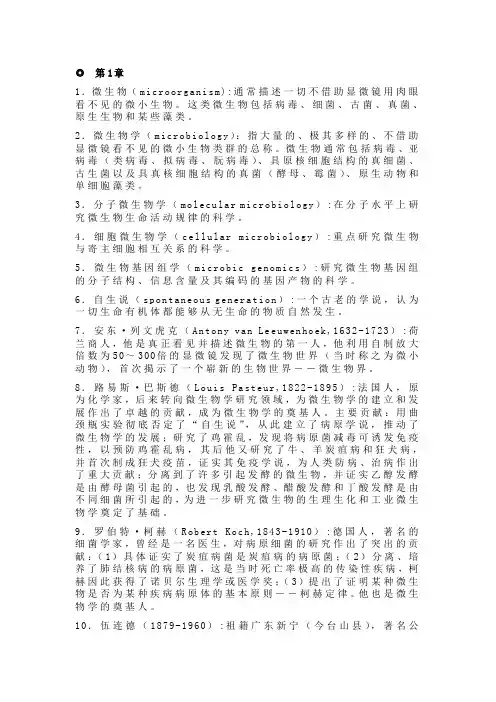
◎第1章1.微生物(mi cr oor g an is m):通常描述一切不借助显微镜用肉眼看不见的微小生物。
这类微生物包括病毒、细菌、古菌、真菌、原生生物和某些藻类。
2.微生物学(m icr o bi ol og y):指大量的、极其多样的、不借助显微镜看不见的微小生物类群的总称。
微生物通常包括病毒、亚病毒(类病毒、拟病毒、朊病毒)、具原核细胞结构的真细菌、古生菌以及具真核细胞结构的真菌(酵母、霉菌)、原生动物和单细胞藻类。
3.分子微生物学(mo le cu la r mi cro b io lo gy):在分子水平上研究微生物生命活动规律的科学。
4.细胞微生物学(ce ll ul ar mi cr ob i ol og y):重点研究微生物与寄主细胞相互关系的科学。
5.微生物基因组学(mi cr ob ic g eno m ic s):研究微生物基因组的分子结构、信息含量及其编码的基因产物的科学。
6.自生说(s po nta n eo us ge ne ra ti on):一个古老的学说,认为一切生命有机体都能够从无生命的物质自然发生。
7.安东·列文虎克(An to ny va n Le e uw en ho ek,1632-1723):荷兰商人,他是真正看见并描述微生物的第一人,他利用自制放大倍数为50~300倍的显微镜发现了微生物世界(当时称之为微小动物),首次揭示了一个崭新的生物世界――微生物界。
8.路易斯·巴斯德(Lo ui s Pa st eur,1822-1895):法国人,原为化学家,后来转向微生物学研究领域,为微生物学的建立和发展作出了卓越的贡献,成为微生物学的奠基人。
主要贡献:用曲颈瓶实验彻底否定了“自生说”,从此建立了病原学说,推动了微生物学的发展;研究了鸡霍乱,发现将病原菌减毒可诱发免疫性,以预防鸡霍乱病,其后他又研究了牛、羊炭疽病和狂犬病,并首次制成狂犬疫苗,证实其免疫学说,为人类防病、治病作出了重大贡献;分离到了许多引起发酵的微生物,并证实乙醇发酵是由酵母菌引起的,也发现乳酸发酵、醋酸发酵和丁酸发酵是由不同细菌所引起的,为进一步研究微生物的生理生化和工业微生物学奠定了基础。
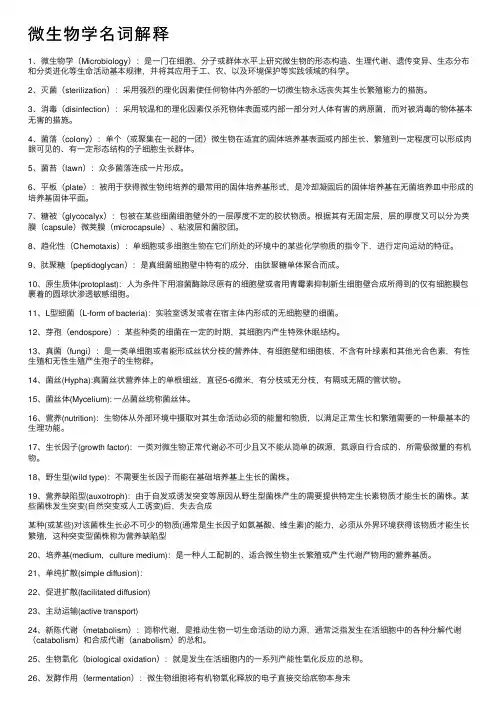
微⽣物学名词解释1、微⽣物学(Microbiology):是⼀门在细胞、分⼦或群体⽔平上研究微⽣物的形态构造、⽣理代谢、遗传变异、⽣态分布和分类进化等⽣命活动基本规律,并将其应⽤于⼯、农、以及环境保护等实践领域的科学。
2、灭菌(sterilization):采⽤强烈的理化因素使任何物体内外部的⼀切微⽣物永远丧失其⽣长繁殖能⼒的措施。
3、消毒(disinfection):采⽤较温和的理化因素仅杀死物体表⾯或内部⼀部分对⼈体有害的病原菌,⽽对被消毒的物体基本⽆害的措施。
4、菌落(colony):单个(或聚集在⼀起的⼀团)微⽣物在适宜的固体培养基表⾯或内部⽣长、繁殖到⼀定程度可以形成⾁眼可见的、有⼀定形态结构的⼦细胞⽣长群体。
5、菌苔(lawn):众多菌落连成⼀⽚形成。
6、平板(plate):被⽤于获得微⽣物纯培养的最常⽤的固体培养基形式,是冷却凝固后的固体培养基在⽆菌培养⽫中形成的培养基固体平⾯。
7、糖被(glycocalyx):包被在某些细菌细胞壁外的⼀层厚度不定的胶状物质。
根据其有⽆固定层,层的厚度⼜可以分为荚膜(capsule)微荚膜(microcapsule)、粘液层和菌胶团。
8、趋化性(Chemotaxis):单细胞或多细胞⽣物在它们所处的环境中的某些化学物质的指令下,进⾏定向运动的特征。
9、肽聚糖(peptidoglycan):是真细菌细胞壁中特有的成分,由肽聚糖单体聚合⽽成。
10、原⽣质体(protoplast):⼈为条件下⽤溶菌酶除尽原有的细胞壁或者⽤青霉素抑制新⽣细胞壁合成所得到的仅有细胞膜包裹着的圆球状渗透敏感细胞。
11、L型细菌(L-form of bacteria):实验室诱发或者在宿主体内形成的⽆细胞壁的细菌。
12、芽孢(endospore):某些种类的细菌在⼀定的时期,其细胞内产⽣特殊休眠结构。
13、真菌(fungi):是⼀类单细胞或者能形成丝状分枝的营养体,有细胞壁和细胞核,不含有叶绿素和其他光合⾊素,有性⽣殖和⽆性⽣殖产⽣孢⼦的⽣物群。
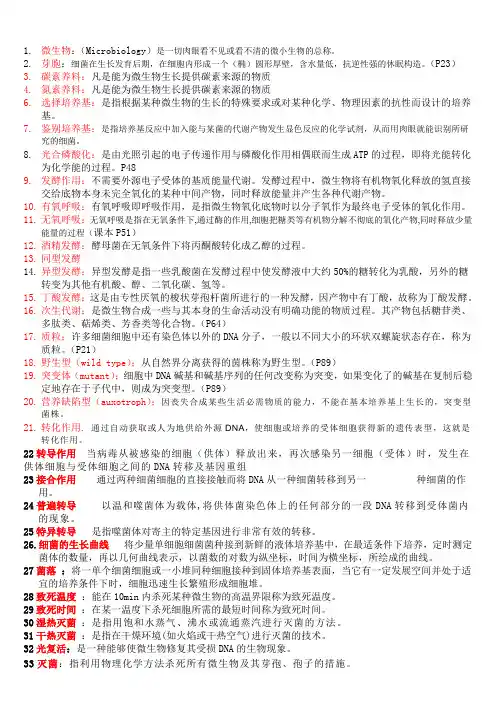
1.微生物:(Microbiology)是一切肉眼看不见或看不清的微小生物的总称。
2.芽胞:细菌在生长发育后期,在细胞内形成一个(椭)圆形厚壁,含水量低,抗逆性强的休眠构造。
(P23)3.碳素养料:凡是能为微生物生长提供碳素来源的物质4.氮素养料:凡是能为微生物生长提供碳素来源的物质6.选择培养基:是指根据某种微生物的生长的特殊要求或对某种化学、物理因素的抗性而设计的培养基。
7.鉴别培养基;是指培养基反应中加入能与某菌的代谢产物发生显色反应的化学试剂,从而用肉眼就能识别所研究的细菌。
8.光合磷酸化:是由光照引起的电子传递作用与磷酸化作用相偶联而生成ATP的过程,即将光能转化为化学能的过程。
P489.发酵作用:不需要外源电子受体的基质能量代谢。
发酵过程中,微生物将有机物氧化释放的氢直接交给底物本身未完全氧化的某种中间产物,同时释放能量并产生各种代谢产物。
10.有氧呼吸:有氧呼吸即呼吸作用,是指微生物氧化底物时以分子氧作为最终电子受体的氧化作用。
11.无氧呼吸:无氧呼吸是指在无氧条件下,通过酶的作用,细胞把糖类等有机物分解不彻底的氧化产物,同时释放少量能量的过程(课本P51)12.酒精发酵:酵母菌在无氧条件下将丙酮酸转化成乙醇的过程。
13.同型发酵14.异型发酵:异型发酵是指一些乳酸菌在发酵过程中使发酵液中大约50%的糖转化为乳酸,另外的糖转变为其他有机酸、醇、二氧化碳、氢等。
15.丁酸发酵:这是由专性厌氧的梭状芽孢杆菌所进行的一种发酵,因产物中有丁酸,故称为丁酸发酵。
16.次生代谢;是微生物合成一些与其本身的生命活动没有明确功能的物质过程。
其产物包括糖苷类、多肽类、萜烯类、芳香类等化合物。
(P64)17.质粒;许多细菌细胞中还有染色体以外的DNA分子,一般以不同大小的环状双螺旋状态存在,称为质粒。
(P21)18.野生型(wild type);从自然界分离获得的茵株称为野生型。
(P89)19.突变体(mutant);细胞中DNA碱基和碱基序列的任何改变称为突变,如果变化了的碱基在复制后稳定地存在于子代中,则成为突变型。
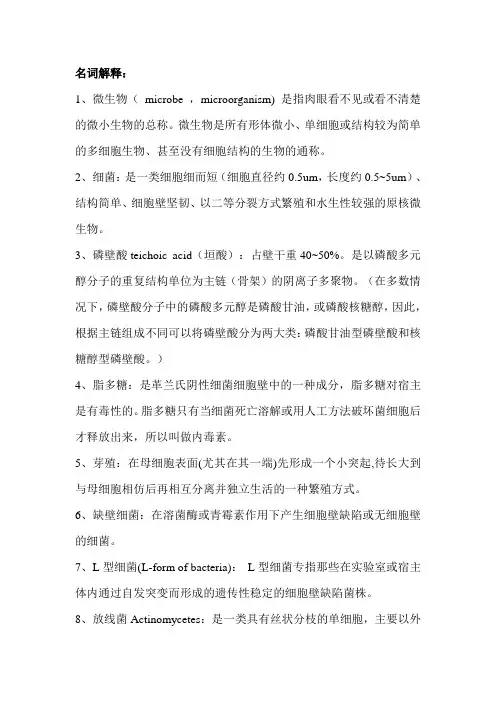
名词解释:1、微生物(microbe ,microorganism) 是指肉眼看不见或看不清楚的微小生物的总称。
微生物是所有形体微小、单细胞或结构较为简单的多细胞生物、甚至没有细胞结构的生物的通称。
2、细菌:是一类细胞细而短(细胞直径约0.5um,长度约0.5~5um)、结构简单、细胞壁坚韧、以二等分裂方式繁殖和水生性较强的原核微生物。
3、磷壁酸teichoic acid(垣酸):占壁干重40~50%。
是以磷酸多元醇分子的重复结构单位为主链(骨架)的阴离子多聚物。
(在多数情况下,磷壁酸分子中的磷酸多元醇是磷酸甘油,或磷酸核糖醇,因此,根据主链组成不同可以将磷壁酸分为两大类:磷酸甘油型磷壁酸和核糖醇型磷壁酸。
)4、脂多糖:是革兰氏阴性细菌细胞壁中的一种成分,脂多糖对宿主是有毒性的。
脂多糖只有当细菌死亡溶解或用人工方法破坏菌细胞后才释放出来,所以叫做内毒素。
5、芽殖:在母细胞表面(尤其在其一端)先形成一个小突起,待长大到与母细胞相仿后再相互分离并独立生活的一种繁殖方式。
6、缺壁细菌:在溶菌酶或青霉素作用下产生细胞壁缺陷或无细胞壁的细菌。
7、L型细菌(L-form of bacteria):L型细菌专指那些在实验室或宿主体内通过自发突变而形成的遗传性稳定的细胞壁缺陷菌株。
8、放线菌Actinomycetes:是一类具有丝状分枝的单细胞,主要以外生孢子的形式繁殖,革兰氏阳性,与细菌同属原核微生物。
放线菌菌落中的菌丝常从一个中心向四周辐射状呈放射状生长,并因此而得名。
放线菌有特殊的土霉味。
9、菌丝(hyphae):具有G+菌细胞壁丝状细胞,没有间隔,为多核体。
可分为基内菌丝、气生菌丝和孢子丝。
成团的菌丝为菌丝体。
10、基内菌丝(substrate hyphae): 培养基内匍匐生长的菌丝,无隔,约0.2-0.8μm。
通常会产生水溶性或脂溶性色素。
功能:吸收营养,所以又称营养菌丝。
11、气生菌丝(aerial hyphae):由营养菌丝长出培养基外,伸向空间的菌丝。
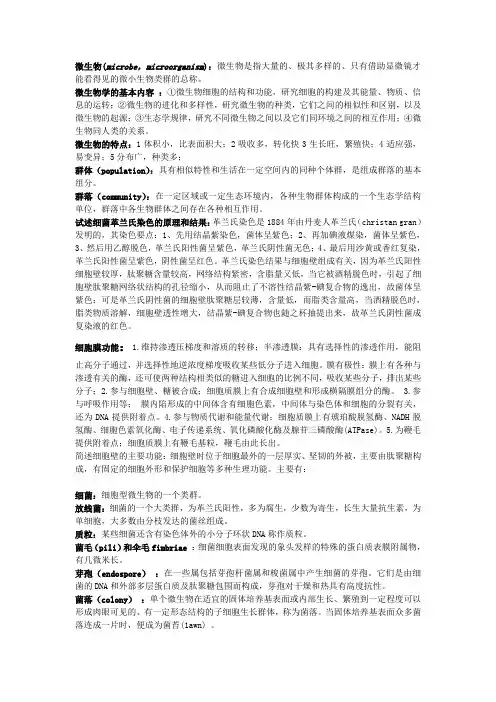
微生物(microbe,microorganism):微生物是指大量的、极其多样的、只有借助显微镜才能看得见的微小生物类群的总称。
微生物学的基本内容:①微生物细胞的结构和功能,研究细胞的构建及其能量、物质、信息的运转;②微生物的进化和多样性,研究微生物的种类,它们之间的相似性和区别,以及微生物的起源;③生态学规律,研究不同微生物之间以及它们同环境之间的相互作用;④微生物同人类的关系。
微生物的特点:1体积小,比表面积大;2吸收多,转化快3生长旺,繁殖快;4适应强,易变异;5分布广,种类多;群体(population):具有相似特性和生活在一定空间内的同种个体群,是组成群落的基本组分。
群落(community):在一定区域或一定生态环境内,各种生物群体构成的一个生态学结构单位,群落中各生物群体之间存在各种相互作用。
试述细菌革兰氏染色的原理和结果:革兰氏染色是1884年由丹麦人革兰氏(christan gran)发明的,其染色要点:1、先用结晶紫染色,菌体呈紫色;2、再加碘液煤染,菌体呈紫色,3、然后用乙醇脱色,革兰氏阳性菌呈紫色,革兰氏阴性菌无色;4、最后用沙黄或香红复染,革兰氏阳性菌呈紫色,阴性菌呈红色。
革兰氏染色结果与细胞壁组成有关,因为革兰氏阳性细胞壁较厚,肽聚糖含量较高,网络结构紧密,含脂量又低,当它被酒精脱色时,引起了细胞壁肽聚糖网络状结构的孔径缩小,从而阻止了不溶性结晶紫-碘复合物的逸出,故菌体呈紫色;可是革兰氏阴性菌的细胞壁肽聚糖层较薄,含量低,而脂类含量高,当酒精脱色时,脂类物质溶解,细胞壁透性增大,结晶紫-碘复合物也随之杯抽提出来,故革兰氏阴性菌成复染液的红色。
细胞膜功能:1.维持渗透压梯度和溶质的转移;半渗透膜:具有选择性的渗透作用,能阻止高分子通过,并选择性地逆浓度梯度吸收某些低分子进入细胞。
膜有极性:膜上有各种与渗透有关的酶,还可使两种结构相类似的糖进入细胞的比例不同,吸收某些分子,排出某些分子;2.参与细胞壁、糖被合成;细胞质膜上有合成细胞壁和形成横隔膜组分的酶。
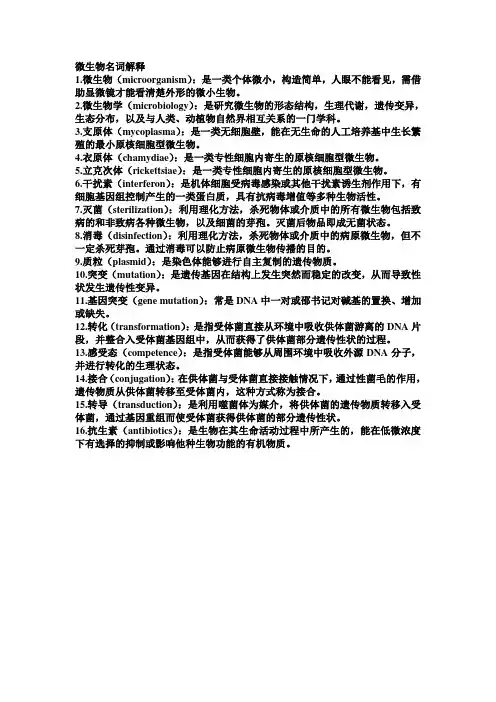
微生物名词解释1.微生物(microorganism):是一类个体微小,构造简单,人眼不能看见,需借助显微镜才能看清楚外形的微小生物。
2.微生物学(microbiology):是研究微生物的形态结构,生理代谢,遗传变异,生态分布,以及与人类、动植物自然界相互关系的一门学科。
3.支原体(mycoplasma):是一类无细胞壁,能在无生命的人工培养基中生长繁殖的最小原核细胞型微生物。
4.衣原体(chamydiae):是一类专性细胞内寄生的原核细胞型微生物。
5.立克次体(rickettsiae):是一类专性细胞内寄生的原核细胞型微生物。
6.干扰素(interferon):是机体细胞受病毒感染或其他干扰素诱生剂作用下,有细胞基因组控制产生的一类蛋白质,具有抗病毒增值等多种生物活性。
7.灭菌(sterilization):利用理化方法,杀死物体或介质中的所有微生物包括致病的和非致病各种微生物,以及细菌的芽孢。
灭菌后物品即成无菌状态。
8.消毒(disinfection):利用理化方法,杀死物体或介质中的病原微生物,但不一定杀死芽孢。
通过消毒可以防止病原微生物传播的目的。
9.质粒(plasmid):是染色体能够进行自主复制的遗传物质。
10.突变(mutation):是遗传基因在结构上发生突然而稳定的改变,从而导致性状发生遗传性变异。
11.基因突变(gene mutation):常是DNA中一对或邵书记对碱基的置换、增加或缺失。
12.转化(transformation):是指受体菌直接从环境中吸收供体菌游离的DNA片段,并整合入受体菌基因组中,从而获得了供体菌部分遗传性状的过程。
13.感受态(competence):是指受体菌能够从周围环境中吸收外源DNA分子,并进行转化的生理状态。
14.接合(conjugation):在供体菌与受体菌直接接触情况下,通过性菌毛的作用,遗传物质从供体菌转移至受体菌内,这种方式称为接合。
微生物名词解释第一、二章1、Microorganism:微生物因个体太小,一般用肉眼看不清楚的生物。
这些微小生物包括:无细胞不能独立生活的病毒、亚病毒(类病毒、拟病毒、朊病毒);具原核细胞结构的真细菌、古生菌以及具真核细胞结构的真菌(酵母、霉菌、蕈菌等)、单细胞藻类、原生动物等。
但其中也有少数成员是肉眼可见的。
2、microbiology:微生物学研究肉眼难以看清的称之为微生物的微小生命活动的科学,分离和培养这些微小生物需要特殊技术。
3、molecular microbiology:分子生物学在分子水平上研究微生物生命活动规律的科学。
4、cellular microbiology:细胞微生物学重点研究微生物与寄主细胞相互关系的科学。
5、microbic genomics:微生物基因组学研究微生物基因组的分子结构、信息含量及其编码的基因产物的科学。
6、spontaneous generation:自生说一个古老的学说,认为一切生命有机体都能够从无生命的物质自然发生。
7、severe acute respiratory syndrome SARS 严重急性呼吸道综合征,即非典型肺炎,也简称非典。
8、colony:菌落单个微生物细胞在适宜固体培养基表面或内部生长、繁殖到一定程度形成的肉眼可见的、有一定形态结构的子细胞生长群体。
9、Lawn:菌苔固体培养基表面众多菌落连成一片时所形成的微生物生长群体。
10、Dish:平板由玻璃或塑料制成的圆形皿底和皿盖组成,皿盖可覆盖于皿底之上形成互扣,防止空气中微生物的污染。
有时也称为培养皿(culture dish)或Petri平皿(petri dish)11、Pure culture:纯培养物由同一组微生物组成的细胞群体,通常是由单个细胞生长繁殖而形成。
12、Culture medium:培养基供微生物生长、繁殖的营养基质,根据其中固化剂含量的不同可分为固体、半固体、液体3种。
医学微生物学名词解释1、microorganism(微生物):是自然界中一大群肉眼不能直接看见,必须借助显微镜放大几百倍或几万倍后才能观察到的一类体积小、分布广、种类多、繁殖快、结构简单、容易变异的微小生物的总称。
3、LPS(脂多糖):是革兰阴性菌细胞壁外膜伸出的特殊结构,即细菌的内毒素,由类脂A、核心多糖和特异多糖构成。
4、细菌L型:细菌在体内外受到各种直接或间接的理化或生物因素影响后,导致细胞壁肽聚糖直接破坏或合成被抑制,进而形成一种细胞壁缺失或缺陷的细菌状态。
(形态多样)5、Plasmid(质粒):是细菌染色体以外的遗传物质,存在于细胞中,为双股闭合环状DNA,控制细菌某些性状,可自我复制,与细菌的遗传变异有关,并非细菌生命活动所必需,可随机获得和丢失。
6、异染颗粒:胞质颗粒用蓝色染料甲基蓝或甲基苯蓝染色时可被染成红色或不同深浅的蓝色,与菌体其他部分不同,显示异染效应,称为~,在菌种鉴定时有一定意义。
16、变异:在一定条件下,子代与亲代之间以及子代与子代之间的生物学性状出现的差异,可以使细菌产生变种和新种。
19、基因转移:外源性遗传物质由供体菌转移至受体菌的过程称为~。
21、转化:供体菌裂解游离的DNA片段被受体菌直接摄取并整合到自己的基因组中,从而使受体菌获得新的遗传性状称为~。
22、转导:以温和噬菌体为载体,将供体菌的一段DNA转移至受体菌内,使受体菌获得新的形状,称为~。
23、溶原性转换:当噬菌体感染细菌时,宿主菌染色体中获得了噬菌体的DNA片段,使其成为溶原状态时而致细菌获得新的性状,称为~。
24、接合:是指细菌通过性菌毛相互连接沟通,将遗传物质(主要是质粒DNA)从供体菌转移至受体菌,使受体菌获得新的遗传性状。
26、消毒:消除和杀灭物体上或环境中病原微生物及其他有害因子的方法,并不一定能杀死含芽胞的细菌或非病原微生物。
用以消毒的药品称为消毒剂。
27、灭菌:杀灭物体上所有微生物的方法,包括杀灭细菌芽胞在内的全部病原微生物和非病原微生物,是预防手术感染或物品污染的最常用的方法。
微生物学名词解释微生物Microbe: 微观的生物机体..细小的肉眼看不见的生物微生物Microorgamism: 微观的生命形式..微生物学microbiology:研究微生物生命活动的科学..微米Micrometer: 一种测量单位:1/1;000mm;缩写为um..原核微生物prokaryotic microbe:指核质和细胞质之间不存在明显核膜;其染色体由单一核酸组成的一类微生物..原核细胞型微生物procaryotic cell microbe:指没有真正细胞核即核质和细胞质之间没有明显核膜的细胞型微生物..真核细胞型微生物eukaryotic cell microbe:指具有真正细胞核即核质和细胞质之间存在明显核膜的细胞型微生物..真菌fungi:有真正细胞核;没有叶绿素的生物;它们一般都能进行有性和无性繁殖;能产生孢子;它们的营养体通常是丝状的且有分枝结构;具有甲壳质和纤维质的细胞壁;并且常常是进行吸收营养的生物..霉菌Mold: 具有丝状结构特征的真菌..细菌bacterium:单或多细胞的微小原核生物..病毒virus:是一类没有细胞结构但有遗传复制等生命特征;主要由核酸和蛋白质组成的大分子生物..是比细菌更小的专性细胞内寄生的微生物;大多数能通过细菌过滤器..放线菌actionomycetes:一目形成真的菌丝成分枝丝状体的细菌..蓝细菌cyanobacterium:是光合微生物;蓝细菌是能进行光合作用的原核微生物..原生生物protistan:指比较简单的具有真核的生物..原生动物protozoa:单细胞的原生生物..免疫学immunology:研究利用预防接种法治疗疾病的科学..立克次氏体Richettsia:节肢动物专性细胞内寄生物;它的许多类型对人和其它动物是致病的微生物..感染Infection: 宿主由于微生物生长的病理学状况..巴氏灭菌法pasteurization:亦称低温消毒法;冷杀菌法;利用较低的温度既可杀死病菌又能保持物品中营养物质风味不变的消毒法..巴斯德消毒法Pasteurization:在一控制温度给液体食物或饮料加热以提高保藏质量;同时也消毁有害的微生物..无菌的Aseptic:没有能够引起感染或污染的微生物..化学疗法chemotherapy:用化学药物来治疗传染病..化学治疗Chemotherapy:用化学制品治疗疾病..抗生素疗法tetracycline:用真菌等生物产生的抗生素来治疗疾病..分类学Tasonomy:尽可能有亲缘关系基础上对有机体的分类..无性繁殖系Clone:从单一细胞传下来的细胞集群..属Genus:一组亲缘关系非常接近的种..分辨率resolving power:能够分辨出两者之间最小的距离..菌株Strain:单一分离体后代组成的微生物纯培养物..污染:微生物纯培养物和灭过菌的物品等被某些杂菌或有害微生物混人或沾染的现象..球菌coccus: 球状的细菌..杆菌bacillus: 杆状的细菌..螺旋状细菌Spirillum: 螺旋状的或开塞钻状的细菌..呈弯曲状的细菌螺旋体Spirochete: 螺旋形细菌;多为寄生性的..梅毒Syphilis:由梅毒密螺旋体引起的一种性病..链球菌Streptococci:分裂后细胞成链的球菌..弧菌:菌体呈有一个弯曲呈弧形即弯度一圈..螺菌:菌体较为坚硬有多个弯曲..衰老型、退化型:细菌在老的培养物中会出现各种与正常形状不一样的个体;重新培养有些可以恢复;有些不可以恢复原来的形状..细菌多型性:有些细菌尽管在最适宜的正常的环境中生长;其形态也很不一致..菌柄Prosthecas:在诸如柄杆菌属的细菌中;作为细胞壁的一部分的附器..球状体球形体;spheroplast:多用革兰氏阴性细菌;以溶菌酶法处理获得;其外壁的结构尚存;所以;原生质体对外界环境具一定抗性;并能在普通培养基上生长的细菌菌体..细菌细胞壁cell-wall:包在表面较坚韧略具有弹性的结构;是一层较薄的膜状结构..核Nucleus:细胞内结构;含有染色体..细胞膜cell membrance:是细胞壁和原生质之间一层柔软并具有半透性的生物膜又叫质膜、原生质膜、胞浆膜..革兰氏染色法Gram stain:一种鉴别染色法;当用脱色剂处理时;根据保留或失去原始着色剂结晶紫与否;细菌被划分为革兰氏阳性或革兰氏阴性..核仁Nucleolus:细胞核中的一种小体..核糖体Ribosome:由RNA和蛋白质组成的细胞质结构单位;为蛋白质合成地点..核糖核酸Ribonucleic acid RNA:见于细胞质和核仁的核酸;含有磷酸;D-核糖;腺嘌呤;鸟嘌呤;胞嘧啶和尿嘧啶..核酸Nucleic acid:一类由核苷酸复合物连接构成的分子;其类型有脱氧核糖核酸和核糖核酸..核蛋白Nucleoprotein:由核酸和蛋白质组成的复合物分子..组蛋白:存在于真核细胞内的一类碱性蛋白其作用之一是使大量遗传信息压缩在核内质粒:细菌除了原核以外;还有染色体外遗传因子为环状DNA分子;能自我复制细胞间的Intercellular:在细胞之间..细胞质Cytoplasm:细胞膜和核之间的细胞生活物质..细胞器Organelle:细胞的结构或组分..荚膜Capsule:围绕某些微生物细胞壁的一种胶状包被或粘液层..细菌细胞壁外的一层较松厚;而且较固定的粘液性物质..粘液层:细菌细胞壁外的一层较松厚;而且较固定的没有明显的边缘粘液性物质..菌胶团:如果细菌荚膜连在一起;其中包含有许多细菌叫菌胶团..细菌的化学趋避运动:细菌趋势向吸引物并聚集于浓度区或与避离排斥物;菌体集中在低浓度区;蛋白质为接受物..细菌的光趋避运动:先培养在具有弱光的液体培养基中;用强光照射某一区域;通过10—100分钟;通过鞭毛运动;集中在强光照射区..鞭毛Flagellum: 细胞上柔软的鞭状的附器细长的原生质突起;作为一种运动器官..一端单毛菌:菌体一端只有一条鞭毛..二端单毛菌:菌体二端各有一条鞭毛..丛毛菌:菌体一端成二端各有一丛鞭毛偏端丛生鞭毛菌、二端丛生鞭毛菌;周毛的Peritichous:围绕细胞整个表面长着鞭毛..周毛菌Peritichous flagellum bacterium:在菌体四周都有鞭毛..伞毛Fimbriae: 某些革兰氏阴性细菌的表面附器;由蛋白质亚单位构成;直径大约为7nm.它们比鞭毛短些、细些..也叫做纤毛..线毛Pili;散毛;纤毛;菌毛:比鞭毛更细;较短;直硬;数量也较多的细丝..核蛋白体核糖体:细胞质中无胞膜的颗粒结构;直径150-200埃..中间体中体:包围质的膜折皱陷入到质细胞里的结构..异染颗粒:用染料多色美兰染色;菌体部分兰色颗粒红紫色;故称异染颗粒..脂类颗粒:细菌在代谢过程中积累起来;但不能被细菌作养料脂类颗粒..多糖颗粒:有糖原和淀粉二类颗粒;可作为细菌的能量来源..液泡Vacuole:细胞质内清晰的空间..芽孢内生孢子Endospora:某些细菌生长到一定阶段;有细胞内形成一个圆形成圆柱形的对不良环境条件具有较强的抵抗力休眠体叫之..孢囊cytocyst:由营养细胞缩短变成球菌;表面形成一层厚的孔壁称之..伴孢晶体parasporal crystal:某些芽孢杆菌;如苏云金杆菌;在细胞内产生一种晶体状多肽类内含物称之..裂殖生殖Schixoteny:营养体多重分裂的无性生殖..裂殖schizogenesis:表现为细胞的横分裂称为裂殖..异形裂殖:裂殖后形成子细胞与母细胞大小不相等;称为异形裂殖..同形裂殖:裂殖后形成子细胞与母细胞大小相等;称为同形裂殖..裂殖体Schizont:疟疾寄生物无性生活周期的一个阶段..菌落集落bacterial colony:固体培养基上肉眼可见的微生物生长物微生物的单个个体或孢子在固体培养基上生长繁殖后形成肉眼可见的集团菌苔bacterial lawn:几个菌落连在一起成片生长..培养基media:是人工配制的适合于不同微生物生长繁殖或者积累代谢产物的营养基质..琼脂Agar-agar:红色海藻经过干燥的多糖抽提物;在微生物学培养基中用以作为一种凝固剂..基内菌丝营养菌丝;substrate mycelium;长在培养基内的放线菌菌丝..菌丝无分隔;可以产生各种水溶性、脂肪性色素;使培养基着色..气生菌丝二级菌丝:由基内营养菌丝长出培养基外伸向空间的放线菌菌丝..气生菌丝直生或分枝丝状;较基内菌丝粗..孢子丝sporotrichial:当生长发育到一定阶段;在其气生菌丝上分化出可形成孢子的放线菌菌丝..水华或水花Bloom:在水中有大量的蓝细菌生长;繁殖茂盛;使水随的颜色随藻类的颜色而变化;许多细胞集结在一起形成“水华”或“水花”..由大量浮游生物生长所引起的水体表面呈色区共生关系symbiotic system:几种生物在有机联系的共生条件下互相得益的关系;有的共生达到了彼此不能分离的程度;或若分离后生长不良..地衣lichen:蓝细菌与真菌形成的共生体..隔膜Septum:菌丝体中的模壁..菌丝hypha:多数真菌的典型营养体呈现丝状或管状单一的细丝叫菌丝叫菌丝..菌丝体mycelium:由许多菌丝连结在一起组成的营养体类型叫菌丝体..有隔菌丝Septa hypha:真菌有隔膜的菌丝叫有隔菌丝..无隔菌丝Non-septa hypha:真菌没有隔膜的菌丝叫无隔菌丝..Z型菌丝Z-hypha:有些真菌的营养体类型;在寄主体内和人工培养基上是两种不同类型的菌体称之..吸器吸胞Haustorium: 真菌菌丝某处生出特殊形态的菌丝体或菌丝的变态物;伸入寄主体内吸取养分;这些变态物叫吸器..菌环菌套annulus: 捕食性真菌形成环状;叫菌环菌套..菌网macterial net: 捕食性真菌形成网状;叫菌菌网..假根Rhizoid:一种单一的或多细胞的在菌丝下方生长出发丝状根状菌丝;伸入基质中吸收养分并支撑上部的菌体;呈根状外观..菌核Sclerotium:真菌生长到一定阶段;菌丝体不断地分化;相互纠结在一起形成一个颜色较深而坚硬的菌丝体组织颗粒..子座Stroma:是菌丝分化形成的垫状结构;或是菌丝体与寄主组织或基物结合而成的垫状结构物..菌索Rhizomorph:是菌丝体集合形成的绳状结构..多生于树皮下或地下;形似根状结构物菌丝束hyphal strand:菌丝平行排列的绳状结构..蕈菌子fungal:由大量菌丝紧密结合形成的真菌子实体..真菌鞭毛cilium:是单独的细胞器;不是孢子体躯的延伸;它来源于中心粒系统;由9+2根微管31根亚纤丝组成结构物..接合孢子zygospore:是接合菌的有性孢子;由菌丝长出形态相同或略有不同的配子囊接合而成..子囊孢子ascospore:子囊菌的有性配子或生于子囊内的有性配子叫之..担孢子basidiospore:担子菌的有性孢子为担孢子;是一种外生孢子..半知菌fungi imperfecti:因为只了解其生活史的一半;因此常称为半知菌..食用菌edible fungi:泛指所有可以吃食的真菌..食用菌edible mushrooms:指真菌中有肥大肉质和胶质的繁殖器官子实体;可以供人类吃食的大型的丝状真菌..毒伞菌poisonous mushrooms:能产生毒素的大型的丝状真菌..发酵ferment:泛指一切利用微生物或酶制剂的生产过程..营养体nutrition body:真菌营养生长阶段的结构称为营养体..无性孢子asexualspore: 无性繁殖产生的孢子称无性孢子..有性孢子sexualspore: 有性繁殖产生的孢子称有性孢子..游动孢子zoosporangiospore:鞭毛菌产生的无性孢子..由割裂方式产生;有鞭毛;在在水中游动..孢囊孢子sporangiospore:接合菌产生的无性孢子..由割裂方式产生;无鞭毛;不能游动..分生孢子Conidium:一种无性孢子;可以为一到多个细胞的;和有许多不同的形状子囊菌、担子菌、半知菌产生的无性孢子; 大多由芽殖、裂殖方式产生..厚垣孢子chlamydospore:各类真菌均可形成的无性孢子;由断裂方式产生;壁厚;寿命长;能抗御不良外界环境..一种厚壁的有抵抗能力的孢子;由菌丝体直接分第而来;菌丝体内原生质和营养物质集中休眠孢子囊resting sporangium:是某些低等鞭毛菌的有性孢子;由鞭毛菌同型两性接合生育而成..卵孢子oospore:是鞭毛菌中卵菌的有性孢子;由异型两性接合生育而成..原配子囊:接合菌相接近的+、—两种菌丝各自向对方生出极短的侧枝叫原配子囊..接合孢子zygospore:是接合菌的有性孢子;由菌丝长出形态相同或略有不同的配子囊接合而成..接合菌:指产生一种叫接合孢子的休眠孢子..接合子Zygote:由两个配子交配而产生的机体..子囊孢子ascospore:子囊菌的有性配子或生于子囊内的有性配子叫之..担孢子basidiospore:担子菌的有性孢子为担孢子;是一种外生孢子..接合作用Conjugation:一种配偶暂时融合的交配过程;尤其见于单细胞有机体..子实体fructification:真菌的产孢结构..担子果或子实体sporophore:高等担子菌中;产生一种高度组织化结构包括担子和担孢子;称为担子果或子实体..担子子实层:担子排列的层叫担子子实层;除担子外;还有刚毛、囊状体..匍匐丝又叫蔓丝:根霉菌体有一部分呈弧形;在培养基表面水平生长;根霉的气生性强;大部分菌丝上匍匐于营养基质表面的气生菌丝..联结假根之间的菌丝假根pesudorhiza:匍匐菌丝在接触培养基处伸入培养基内呈分枝状生长的菌丝..同宗结合homothallic:单个菌株能完成有性交配..异宗结合heterothallic:单个菌株自身不孕;必须与另一菌株相对应的性器官配合才能完成有性交配..子囊子实层ascusic hymenium:子囊排列的层叫子囊子实层;子实层除子囊外;还有则丝、不育丝..子实层hymenium:子囊着生在一个盘状开口的子囊果内..子实体Fruiting body:一种特化的产生孢子的器官..真菌的产孢结构子囊Ascus:子囊类特征的囊状结构;里面产生子囊孢子..一种囊状产孢结构;球形、棒形成圆筒形子囊壳Perithecium:球形、圆筒形或卵形的子囊果;它通常在顶部开一条裂缝或小孔..子囊孢子ascospore:子囊菌的有性配子或生于子囊内的有性配子叫之..子囊果ascocarp:子囊菌亚门真菌产生子囊孢子的结构闭囊壳子囊球cleistothecium:子囊被包在一个球形无孔的子囊果中..子囊盘apothecium:呈盘状、碗状成漏斗状;顶部敞开的叫子囊盘..假囊壳pseudothecium:子座内只有一个子囊腔;顶端有溶化的假孔口..子囊座ascostroma:子囊座瓶状、盾状或船状等;子座内有1至多个子囊腔;有或无孔口..子囊腔locule: 子囊座内着生子囊的腔..担孢子basidiospore:担子菌的有性孢子为担孢子;是一种外生孢子..担子果或子实体basidiocarps:高等担子菌中;产生一种高度组织化结构包括担子和担孢子;称为担子果或子实体..裸果型担子果:子实层自始裸露于外..被果型担子果:子实层包在子实体内;孢子在担子果分解或遭遇外力破裂时才释放于外..半被果型担子果:子实层初期被菌幕所覆盖;成熟后全部裸露于外..担子子实层:担子排列的层叫担子子实层;除担子外;还有刚毛、囊状体..生活史:微生物一生中所经历的发育和繁殖阶段的全部过程..初生菌丝一生菌丝:是由担孢子萌发产生的单核单倍体的菌丝..次生菌丝二生菌丝:是由初生菌丝联合进行质配而不进行核配的双核菌丝..三生菌丝:是组织化的特殊的一些双核组织菌丝;常集结成特殊的形状的子实体即蕈子蕈菌子:由大量菌丝紧密结合形成的真菌子实体..锁状联合clampconnection:担子菌的次生菌丝每一个细胞都有二个核;其中一个核来自母本;一个来自父本;当双核细胞进行细胞分裂时;在二个核之间处生一个短小弯磨曲的分枝;核移动;在二核之间生出一个突起如钩状;一个核进入钩一个留在菌丝钩中保留一个核;一个往后移;菌丝中二个核一往前一个往后移钩状突起向下弯曲与细胞壁接触溶化;分枝基部生分隔膜分隔中间有孔道;在原分支外形成一隔膜;产生一个新细胞双核体;在分隔处保留一个桥形结构叫之..蘑菇圈、仙人圈fairy ring:是由于菌丝辐射生长的缘故..菌丝由中间一点向四周辐射生长;时间长了;中心点及老化的菌丝相继死去;外面的生活力强;于是形成了自然的菌丝体环..菌托teleoblem:包在担子果子实体的菌柄基部的膜状物..子实体幼小期包有一层外膜;当菌柄伸长时;外膜破裂残留在菌柄基部形成菌托菌环annulus:围绕菌柄的一个环状物..菌柄stipe:伞菌子实体的柄..位于菌盖下面;有正中生、侧生、偏生..菌盖cap:子实体的帽状部分..位于菌柄上方..菌褶gill:菌盖下方与菌肉相连的部分; 菌褶似刀片呈辐射状排列..半知菌fungi imperfecti:因为只了解其生活史的一半;因此常称为半知菌..分生孢子梗Conidiophore:从菌丝体上形成分化程度不同的产生分生孢子的结构..菌丝体的分枝;其上着生分生孢子分生孢子座Sporodochidium:分生孢子梗以聚生的着生形式聚集成垫状的短梗形式;顶端产生分生孢子;形成孢子座的结构..束丝:以聚生的着生形式形成一束排列较紧密的直立分生孢子梗;顶端或侧面产生分生孢子..分生孢子盘Acervulus:半知菌形成盘状的孢子果..分生孢子器Pycnidium:半知菌形成球状的孢子果..酵母菌yeast:指一群单细胞的真核微生物单细胞的不具典型菌丝体特征的一类真菌假菌丝体pseudomycelium:单细胞菌体互相连接在一起成为一串细胞象菌丝称之..二型现象dimorphism:一定条件下形成单细胞菌体;另一条件下则形成菌丝体..蕈菌子fungal:由大量菌丝紧密结合形成的真菌子实体..出芽Budding:酵母无性生殖的典型形式;在此过程中多亲代细胞长出一个新的细胞..地衣Lichem:藻类和真菌类共生;互惠的结合物..黄曲霉毒素Aflatoxin:一些真菌黄曲霉品系产生的毒素;一种致癌物..菌根Mycorrhiza:真菌和高等植物的根的共生联系..假根Rhizoid:一种单一的或多细胞的发丝状结构;呈根状外观..游动孢子Zoospore:运动的有鞭毛的孢子..藻菌植物Thallophyte: 不具真正的茎、根或叶的植物;包括藻类和真菌..白僵菌Beauveria:半知局亚门;菌丝有横隔有分枝的真菌..白僵菌可以侵入6个目15科200多种昆虫、螨类的虫体内大量繁殖;同时不断产生白僵素大环脂类毒素和草酸钙结晶;这些物质可引起昆虫中毒;使体液发现机能发生变化;打乱新陈代谢以致死亡..绿僵菌Beauveria:与白僵相似;菌体橄榄绿色..病毒学virology:研究病毒的科学..滤过性病毒Filterable virus:能够通过细菌过滤器小孔的微生物..二十面体Icosahedron:许多病毒粒子的几何形状;二十个三角面和二十个角..干扰素Ioterferon:动物组织产生的抗病毒物质..病毒粒子病毒个体virus particle:是成熟的、完整的、有感染性病毒颗粒..壳体capsomers:由多个衣壳粒组成的蛋白质外壳..核壳体核衣壳:是衣壳与其包围着的核酸的总称..衣壳粒capsomer:衣壳单个的蛋白质亚单位..病毒的最小形态单位;由一种或几种多肽链折叠而成的蛋白质亚单位..衣壳capsid symmetry:衣壳粒以对称形式有规律地排列;形成的蛋白质外壳..封套envelope:一般由含有类脂或脂蛋白质组成的包围着病毒核壳体的包膜..细菌过滤器Filter;bacterial:细菌不能通过的特殊类型的过滤器..寄生现象Parasitism:被寄生物感染的状态..专性寄生:寄生的一种类型;只能依赖活的寄主生存;脱离寄主不能生活和繁殖..接种Inoculation:人为地把微生物或物质引进体内或培养基..接种物Inoculum:含有微生物的材料;用于接种..溶菌现象:液体培养时细菌被噬菌体裂解;液体由混浊变清的现象..噬菌斑phague:烈性噬菌体+敏感性细菌混合培养于固体基质中;由于噬菌体进行裂解细菌;而在营养琼脂平板上形成的透明空斑..噬菌体bacteriumphage:是微生物病毒;是侵染细菌、放线菌、真菌等细胞型微生物的病毒..烈性噬菌体lytic bacteriumphage:感染细胞后引起细菌细胞裂解的噬菌体..温和噬菌体Temperate bacteriophage:能与宿主细菌同步复制的噬菌体;因而在噬菌体不需引起溶菌就能通过胞分裂遗传..原噬菌体protophage:温和噬菌体以其核酸附着在细菌染色体的一定位置上;与细菌染色体一道复制;称原噬菌体..结果:每个子细胞都成为溶解性细菌..敏感性细菌sensitized bacterium:被裂性噬菌体侵染的细菌..溶源性Lysogeny::携带噬菌体的细菌状态;对这种噬菌体;细菌本身并不敏感..溶原性细菌lysogenic bacterium:含有温和噬菌体的细菌..感病infection disease:寄主遭受病原物的侵染而发病..侵染力infestation:病原微生物克服寄主防御能力;侵入体内得以生长、繁殖和扩散等一系列的性能..病原pathogenium:引起病害的病原生物..抗原性:能与免疫反应产物结合的性质..亚病毒:没有真病毒的形态结构;能利用非自身编码的酶系统进行复制;有侵染性;并可在寄主中引起症状..类病毒viroid:是寄生于高等生物细胞中一类最小的新病原体;有类似病毒的一面;称为类病毒..卫星RNAstar RNA:是指一些必须依赖于辅助病毒的才能复制的小分子单链RNA片段;它被包装在辅助病毒的包体中..拟病毒Viroid—Like RNA:是一种类似于类病毒的病毒;其核酸组成;大小、二级结构均与类病毒相似;故又称之为类似类病毒Viroid—Like RNA;又称为拟病毒;朊病毒:只含蛋白质外壳不含核酸的病毒..朊—蛋白质曾用名;现已不用CJDCreutzfeldt-Jakob Ddisease:医源性“海绵类脑血管病变或朊病毒”感染;是世界性顽疾之一..病征:四肢僵值;语无论次;尿便失禁..噬放线菌:把侵染放线菌的病毒叫噬放线菌..噬蓝藻体cyanophage:是侵染多种蓝藻的病毒..噬真菌体mycophage:是侵染多种真菌的病毒..类菌原体Mycoplasma like organism=MLO:又称类菌原质;它是介于病毒和细菌之间的一种单细胞微生物;比细菌小比病毒大;具有多型性;有圆形、椭圆形或不规则形;大小为200-300nm;没有细胞壁..螺原体Spiroplasma:呈螺旋丝状;长3—25um; 直径在100-200nm;高度变态..菌原体thalline:动物的微小原核原生生物;高度变态;如球状或近卵球状;直径125-250nm..类立克次氏体Rickettsia-Lick Organism RLO:这类微生物形态结构和性状与立克次氏体极相似;故称之..类细菌Rickettsia-Lick Bacteria : 类立克次氏体是一种小形杆状细菌;又不同于细菌;寄生于细胞内部;有细胞壁;有固定的形态;与细菌同属于一个门;又称为类细菌;一般不能人工培养..。
/kech/wswx/cn/test/shiti.htm华中农业大学微生物试题集(仅参考)*不做重点*Section 1 Microorganisms and Microbiology1Archaea :a group of phylogenetically related prokaryotes distinct from Bacteria2Bacteria :a group of phylogenetically related prokaryotes distinct from Archaea 3 Chromosome:a genetic element carrying genes essential to cell function4DNA :deoxyribonucleic acid, the hereditary material of cells and some viruses 5 Enrichment culture:a method for isolating microorganisms from nature using specific culture media and incubation conditions6 Enzymes :protein catalysts that function to speed up chemical reactions7 Eukaryote:a cell possessing a membrane-enclosed nucleus and usually other organelles8Genetics :heredity and variation of living organisms9Microorganism :a microscopic organism consisting of a single cell or cell cluster, including the viruses10 Plasmid:a small genetic element that exists separately from the chromosome 11Pure culture :a culture containing a single kind of microorganism12Spontaneous generation :the hypothesis that living organisms can originate from nonliving matter13Aseptic :technique methods for maintaining sterile culture media and other sterile objects free from microbial contamination during manipulations14Cell :the fundamental unit of living matter15Cytoplasm :the fluid portion of a cell, bounded by the cell membrane but excluding the nucleus (if present)16Ecology :the study of organisms in their natural environments17 Entropy:a measure of the degree of disorder in a system; entropy always increases in a closed system18Eukarya :all eukaryotic organisms19Evolution :change in a line of descent over time leading to the production of new species or varieties within a species20Metabolism :all biochemical reactions in a cell21 Pathogen:a disease-causing microorganism22 Prokaryote:a cell lacking a nucleus and other organelles23 RNA:ribonucleic acid, involved in protein synthesis as messenger RNA, transfer RNA, and ribosomal RNA24 Sterile:absence of all living organisms and virusesSection 2 Cell Biology1Antigen-Binding Cassette transporter :a membrane transport system consisting of three proteins, one hydrolyzes ATP as an energy source to drive the transport event, one binds the substrate on the outside of the cell, and one functions as the transport channel through the membrane2Chloroplast :the chlorophyll-containing photosynthetic organelle of eukaryotic photosynthetic organisms3 Cytoplasmic:membrane the permeability barrier of the cell, separating the cytoplasm from the environment4 Eukaryote :a cell containing a membrane-enclosed nucleus and usually other organelles5Gas vesicles :gas-filled cytoplasmic structures bounded by protein and coriferring buoyancy on cells6 Gram-positive:a prokaryotic cell whose cell wall consists chiefly of peptidoglycan and lacks the outer membrane of gram-negative cells7Lipopolysaccharide (LPS):lipid in combination with polysaccharide and protein forming the major portion of the cell wall in gram-negative Bacteria8 Mitochondrion (mitochondria):an organelle found in most eukaryotic cells in which respiration and energy generation occurs9Nucleus:a membraned-enclosed structure in cells of Eukarya that contains the genetic material, arranged in chromosomes10 Flagellum:Peptidoglycan :a polysaccharide composed of alternating repeats of acetylglucosamine and acetylmuramic acid with the latter in adjacent layers cross-linked by short peptides11 Peritrichous:in reference to flagellation pattern; flagella located in many places around the surface of the cell Phototaxis movement of an organism toward light12 Prokaryote:a cell that lacks a membrane-enclosed nucleus and that usually has a single circular DNA molecule as its chromosome13 Ribosome :small particles composed of RNAs and proteins that function in protein synthesis14Chemotaxis :movement of an organism toward (positive) or away from (negative) a chemical gradient15Chromosome :a DNA molecule, usually circular in prokaryotes and linear in eukaryotes, carrying genes essential to cellular function16Endospore:a highly heat-resistant, thick-walled, differentiated cell produced by certain gram-positive Bacteria17 Flagellum :a long, thin cellular appendage capable of rotation in prokary otic cells and responsible for swim-ming motility18 Gram-negative:a prokaryotic cell whose cell wall contains relatively little peptidoglycan but contains an outer membrane composed of lipopolysaccharide, lipoprotein, and other complex macromolecules19 Group translocation:an energy-dependent transport process in which the substance transported is chemi-cally modified during the transport process20 Magnetosomes:particles of magnetite (Fe3O4) organized into nonunit membrane-enclosed structures in the cytoplasm of magnetotactic Bacteria21 Nucleoid:an aggregated state of the circular chromosome of prokaryotic cells22 Organelle:a unit membrane-enclosed structure found in the cytoplasm of eukaryotic cells23Periplasm :a gellike region between the outer surface of the cytoplasmic membrane and the inner surface of the lipopolysaccharide layer of gram-negative Bacteria24 Poly-P-hydroxybutyrate (PHB):a common storage material of prokaryotic cells consisting of a polymer of P-hydroxybutyrate or another 3-alkanoic acid25 Protoplast :an osmotically protected cell whose cell wall has been removedSection3 Prokaryotic Microorganisms1 Acid fastness:a property of Mycobacterium species in which cells stained with the dye basic fuchsin resist decolorization with acidic alcohol2Chemolithotrophs :organisms able to oxidize inorganic compounds as energy sources3 Consortia:two or more-membered association of prokaryotes, usually living in an intimate symbiotic fashion4Enteric bacteria :a large group of gram-negative rod-shaped Bacteria characterized by a facultatively aerobic metabolism5 Heliobacteria:anoxygenic phototrophs containing bacteriochlorophyll g6Heterocyst :a differentiated cyanobacterial cell that carries out nitrogen fixation but not oxygenic photosynthesis7Homofermentative :in reference to lactic acid bacteria, producing only lactic acid as a fermentation product8 Methylotroph :an organism capable of oxidizing organic compounds that do not contain carbon-carbon bonds; if able to oxidize CH4, also a methanotroph9 Purple nonsulfur bacteria:a group of phototrophic prokaryotes containing bacteriochlorophylls a or b that grow best as photoheterotrophs and have a relatively low tolerance for H2S10 Prostheca :an extrusion of cytoplasm often forming a distinct appendage, bounded by the cell wall11 Pseudomonad:member of the genus Pseudomonas, a large group ofgram-negative, obligately respiratory (never fermentative) Bacteria12 Spirochete :a slender, tightly coiled gram-negative prokaryote characterized by possession of axial filaments used for motility13 Sulfate-reducing bacteria :a large group of anaerobic Bacteria that respire anaerobically with SO42- as electron acceptor, producing H2S14 Carboxysomes :polyhedral cellular inclusions of crystalline ribulose bisphosphate carboxylase (RubisCO), the key enzyme of the Calvin cycle15Chlorosomes :cigar-shaped structures bounded by a nonunit membrane and containing the light-harvesting bacteriochlorophyll (c, d, or e) in green bacteria and Chloroflexus16 Cyanobacteria :prokaryotic oxygenic phototrophs that contain chlorophyll a and phycobilins but not chlorophyll b17 Green bacteria:anoxygenic phototrophs containing chlorosomes and bacteriochlorophyll c, cs, d, or e as light-harvesting chlorophyll18 Hyperthermophile:an organism with a growth temperature optimum of greater than 80oC19Heterofermentative :in reference to lactic acid bacteria, capable of making more than one fermentation product20 Methanotroph :an organism capable of oxidizing methane (CH4)21 Nitrifying bacteria:chemolithotrophs capable of carrying out the transformation NH3?NO2- or NO2-?NO3-22 Prochlorophyte :a prokaryotic oxygenic phototroph that contains chlorophyllsa andb but lacks phycobilins23 Proteobacteria :a major lineage of Bacteria that contains a large number of gram-negative rods and cocci24Purple sulfur bacteria :a group of phototrophic prokaryotes containing bacteriochlorophylls a or b and characterized by the ability to oxidize H2S and store elemental sulfur inside the cells (or in the genus Ectothiorhodospira, outside the cell)25 Stickland reaction :fermentation of an amino acid pair in which one amino acid serves as an electron donor and a second serves as an electron acceptor Section4 Eukaryotic Microorganisms1Ameboid movement :a type of motility in which cytoplasmic streaming moves the organism forward2Chloroplast:the photosynthetic organelle of eukaryotic phototrophs3 Conidia:asexual spores of fungi4Flagellates :a group of protozoa characterized by motility driven by the whiplike action of one or more long,thin appendages called flagella5 Hydrogenosome:an organelle of endosymbiotic origin present in certain anaerobic eukaryotic microorganisms that functions to oxidize pyruvate to H2, CO2, and acetate, along with the production of one ATP6 Molds:filamentous fungi7Phagocytosis :a mechanism for ingesting particulate food in which a portion of the cell membrane surrounds the particle and brings it into the cell8 Slime molds:nonphototrophic eukaryotic microorganisms that lack cell walls and that aggregate to form fruiting structures (cellular slime molds) or masses of protoplasm (acellular slime molds)9 Yeasts:unicellular fungi10Chitin :a polymer of N-acetylglucosamine commonly found in the cell walls of algae and fungi11 Ciliates:a group of protozoa characterized by rapid motility driven by numerous short appendages called cilia12 Eukarya :all eukaryotic organisms13Fungi :nonphotosynthetic eukaryotic microorganisms that contain rigid cell walls14 Mitochondrion:the respiratory organelle of eukaryotic organisms15 Mushrooms :filamentous fungi that produce large, often edible structures called fruiting bodies16 Protozoa :unicellular eukaryotic microorganisms that lack cell walls17 Sporozoa :nonmotile parasitic protozoaSection 5 Viruses1Bacteriophage:a virus that infects prokaryotic cells2Lysogen:a bacterium containing a prophage3Oncogene:a gene whose expression causes formation of a tumor4Plus (positive)-strand nucleic acid :an RNA or DNA strand that has the same sense as the mRNA of a virus5Provirus (prophage):the genome of a temperate virus when it is replicating with, and usually integrated into,the host chromosome6Reverse transcription:the process of copying information found in RNA into DNA7Transformation :a process by which a normal cell becomes a cancer cell (but see alternative usage in Chapter 9)8Virulent virus:a virus that lyses or kills the host cell after infection; a nontemperate virus9Minus (negative)-strand nucleic acid:an RNA or DNA strand that has the opposite sense of (is complementary to) the mRNA of a virus10Plaque:a zone of lysis or cell inhibition caused by virus infection of a lawn of sensitive cells11Prion:an infectious agent whose extracellular form may contain no nucleic acid12 Retrovirus:a virus whose RNA genome has a DNA in-termediate as part of its replication cycle13Temperate virus :a virus whose genome is able to replicate along with that of its host and not cause cell death in a state called lysogeny14 Virion:the complete virus particle; the nucleic acid surrounded by a protein coat and in some cases other material15Virus:a genetic element containing either RNA or DNA that replicates in cells but is characterized by having an extracellular stateSection 6 Nutrition and Metabolism1Activation Energy energy the energy required to bring substrates to the reactive state2 Anabolism:the sum total of all biosynthetic reactions in the cell3 Catabolism:biochemical reactions leading to the production of usable energy (usually ATP) by the cell4 Chemoorganotroph :an organism that uses organic chemicals as energy sources (electron donors)5 Coenzyme :a small nonprotein molecule that participates in a catalytic reaction as part of an enzyme6 Culture medium :an aqueous solution of various nutrients suitable for the growth of microorganisms7 Electron acceptor:a substance that can accept electrons from some other substance, thereby becoming reduced in the process8 Enzyme:a protein that has the ability to speed up (catalyze) a specific chemical reaction9 Free energy :(G) energy available to do work10 Phototroph :an organism capable of using light as an energy source11 Reduction potential :the inherent tendency (measured in volts) of a compound to donate electrons12Siderophores :iron chelators that can bind iron present at very low concentrations13 Aerobe :a microorganism able to use O2 in respiration14 Autotroph :an organism capable of biosynthesizing all cell material from CO2 as the sole carbon source15 Chemolithotroph:an organism that uses inorganic chemicals as energy sources (electron donors)16 Citric acid cycle :a cyclical series of reactions resulting in the conversion of acetate to two CO217 Complex medium:a culture medium composed of digests of chemically undefined substances such as yeast and meat extracts18 Defined medium :a culture medium whose precise chemical composition is known19 Electron donor:a substance that can donate electrons to some electron acceptor, thereb y becoming oxidized in the process20 Fermentation:anaerobic catabolism in which an organic compound serves as both an electron donor and an electron acceptor and in which ATP is produced by sub-strate-level phosphorylation21 Oxidative phosphorylation:the production of ATP at the expense of a proton motive force formed by electron transport22Proton motive force :an energized state of the membrane resulting from the separation of charge and the elements of water (H+ versus OH?) across the membrane23Respiration :the process in which a compound is oxidized with O2 or an O2 substitute functioning as the terminal electron acceptor, usually accompanied by ATP production by oxidative phosphorylation24 Substrate-level phosphorylation :production of ATP by the direct transfer of a high energy phosphate molecule from a phosphorylated organic compound to ADPSection 7 Microbial Growth and Growth Control1 Acidophile:an organism that grows best at low pH2 Alkaliphile :an organism that grows best at high pH3Batch culture :a closed-system microbial culture of fixed volume4 Compatible solute:a molecule that is accumulated in the cytoplasm for adjustment of water activity but that does not inhibit biochemical processes5 Extremophile:an organism that grows optimally under one or more chemical or physical extremes, such as high or low temperature or pH6 Generation time:the time required for a population of microbial cells to double7 Halophile:a microorganism that requires NaCI for growth8 Lag phase:a period preceding the exponential growth phase when cells may be metabolizing but are not yet growing9 Mesophile:an organism that grows best at temperatures between 20 and 45oC10 Psychrophile:an organism with a growth temperature optimum of 15oC or lower and a maximum growth temperature below 20oC11 Stationary phase:the period immediately following exponential growth when the growth rate of the population falls to zero12Viable :capable of reproducing13 Aminoglycosides :a group of antibiotics, including streptomycin, containing amino sugars linked by glycosidic bonds14 Antibiotic resistance :the acquired ability of a microorganism to grow in the presence of an antibiotic to which the microorganism is usually sensitive15Antiseptic :antimicrobial agents that are sufficiently nontoxic to be applied on living tissues16β-Lactam antibiotics:a group of antibiotics, including penicillin, that contain the four-membered heterocyclic β-lactam ring17 Bacteriostatic:inhibits bacterial growth18 Decontamination:treatment that renders an object or inanimate surface safe to handle19 Disinfection:the process of eliminating nearly all pathogens, but not all microorganisms, from inanimate objects or surfaces20 Inhibition:the reduction of microbial growth because of a decrease in the number of organisms present or alterations in the microbial environment21 Lysis:loss of cellular integrity with release of cytoplasmic contents22 Semisynthetic penicillin :a natural penicillin that has been chemically altered23 Tetracycline:an antibiotic characterized by a four-mem-bered naphthacene ring24 Aerobe:an organism that can use O2 in respiration; some require O2 for growth25 Anaerobe :an organism that cannot use O2 in respiration and whose growth may be inhibited by O226 Chemostat:a device that allows for the continuous culture of microorganisms in which both growth rate and cell number can be controlled independently27 Exponential growth:growth of a microorganism where the cell number doubles within a fixed time period28 Facultative:with respect to O2, an organism that can grow in either its presence or absence29Growth :an increase in cell number30 Hyperthermophile:a microorganism that has a growth temperature optimum of 80oC or greater31 Lysis:loss of cellular integrity with release of cytoplasmic constituents32 Microaerophile:an aerobic organism that can grow only when oxygen tensions are reduced from that in air33Psychrotolerant :an organism capable of growth at low temperatures but whose growth temperature optimumis above 20oC34 Thermophile:an organism whose growth temperature optimum lies between 45 and 80oC35 Xerophile:an organism that is able to live, or that lives best, in very dry environments36Antibiotic :a chemical substance produced by a microorganism that kills or inhibits the growth of another microorganism37 Antimicrobial agent:a chemical that kills or inhibits the growth of microorganisms38 Autoclave:a sterilizer that destroys microorganisms with temperature and steam under pressure39 Bacteriocidal:kills bacteria40 Chemotherapeutic agent:an antimicrobial agent that can be used internally41 Disinfectant:an antimicrobial agent used only on inanimate objects42 Growth factor analog :a chemical agent that is related to and blocks the uptake of a growth factor43Interferons :host-specific antiviral proteins, produced by virus-infected cells, which prevents viral infection of neighboring cells44 Pasteurization:destruction of all disease-producing microorganisms or a reduction in the number of spoilage microorganisms45 Sterilization:the killing or removal of all living organisms and their viruses from a growth mediumSection 8 Microbial Genetics1Auxotroph :an organism that has developed a nutritional requirement through mutation2 Diploid:a eukaryotic cell or organism containing two sets of chromosomes3 Electroporation:the use of an electric pulse to induce cells to take up free DNA 4Genetic map:the arrangement of genes on a chromosome5 Genotype:the precise genetic makeup of an organism6 Mutagens:agents that cause mutation7 Mutation:an inheritable change in the base sequence of the genome of an organism8 Plasmid:an extrachromosomal genetic element that has no extracellular form9 Recombination:the process by which parts or all of the DNA molecules from two separate sources are exchanged or brought together into a single unit10Selection:placing organisms under conditions where the growth of those with a particular genotype will be favored11Transformation:transfer of bacterial genes involving free DNA (but see alternative usage in Chapter 8)12Conjugation:transfer of genes from one prokaryotic cell to another by a mechanism involving cell-to-cell contact and a plasmid13Transposon :a type of transposable element that carries genes in addition to those involved in transposition14Gametes:in eukaryotic organisms, the haploid germ cells resulting from meiosis15 Genome:the total complement of genes of a cell or a virus16 Haploid:a cell or organism that has only one set of chromosomes17Mutant:an organism whose genome carries a mutation18 Phenotype:the observable characteristics of an organism19 Point mutation:a mutation that involves one or only a very few base pairs20 Screening:any of a number of procedures that permit the sorting of organisms by phenotype or genotype, but allow the growth of those possible21 Transduction:transfer of host genes from one cell to another by a virus22Transposable element:a genetic element that has the ability to move (transpose) from one site on a chromosometo anotherSection 9 Microbial Ecology1Acid mine drainage :addic water containing H4SO4 derived from the microbial oxidation of iron sulfide minerals2Bacteroid:morphologically misshapen Rhizobium cells inside a leguminous plant root nodule; can fix N23Barophilic:an organism that grows best when placed under a pressure greater than 1 atm4 Biofilm:colonies of microbial cells encased in slime and attached to a surface5 Black smoker:an extremely hot (250-350oC) deep-sea hot spring emitting both hot water and various minerals6 Ecosystem:a community of organisms and their natural environment7FISH :fluorescent in situ hybridization8Hydrothermal vent :a deep-sea warm or hot spring, Infection thread in the formation of root nodules, a cellulosic tube through which Rhizobium cells can travel to reach and infect root cells9 Interspecies hydrogen transfer:the production and subsequent consumption of H2 by different groups of microorganisms that interact closely during anaerobic catabolism10 Lichen:a fungus and an alga (or cyanobacterium) living in symbiotic association11 Microenvironment:the immediate environmental surroundings of a microbial cell or group of cells12Optical tweezers :a laser microscope able to trap single cells and remove them from a cell mixture13Primary producer :an organism that uses light to synthesize new organic material from CO214Reductive dechlorination :removal of Cl as Cl? from an organic compound by reducing the carbon atom from C?Cl to C?H15Root nodule:a tumorlike growth on plant roots that contains symbiotic nitrogen-fixing bacteria16 Ti plasmid:a conjugative plasmid present in the bacterium Agrobacterium tumefaciens that can transfer genes into plants17Anoxic:?18Xenobiotic :a totally synthetic product not naturally occurring in nature19Barotolerant :an organism that can grow under elevated pressures but that grows best at atmospheric pressure20 Biogeochemistry:study of biologically mediated chemical transformations21 Cometabolism:metabolism of a compound in the presence of a second organic compound, which is used as the primary energy source22 Enrichment culture:a means of obtaining cultures of microorganisms from a natural environment by using highly selective culture methods23 Guild:a population of metabolically related microorganisms24In situ:in the environment25 Leaching:solubilization and removal of metals from an ore by microbial attack 26Microbial plastics:biodegradable polymeric materials obtained from microorganisms that have properties similar to those of synthetic plastics27 Mycorrhiza:a symbiotic association between a fungus and the roots of a plant28Oxic:?29 Pyrite:a common iron-containing ore, FeS230Rhizosphere:the region immediately adjacent to plant roots31Rumen:the first vessel in the multichambered stomach of ruminant animals in which cellulose digestion occurs。